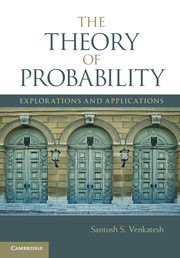Refine search
Actions for selected content:
6791 results in Communications and signal processing
10 - Communications in the turbulence channel
-
- Book:
- Fundamentals of Electro-Optic Systems Design
- Published online:
- 05 February 2013
- Print publication:
- 20 December 2012, pp 179-248
-
- Chapter
- Export citation
7 - Forward error correction coding
-
- Book:
- Fundamentals of Electro-Optic Systems Design
- Published online:
- 05 February 2013
- Print publication:
- 20 December 2012, pp 121-140
-
- Chapter
- Export citation
9 - Light detection and ranging
-
- Book:
- Fundamentals of Electro-Optic Systems Design
- Published online:
- 05 February 2013
- Print publication:
- 20 December 2012, pp 151-178
-
- Chapter
- Export citation
Enclosure methods for Helmholtz-type equations
-
-
- Book:
- Inverse Problems and Applications
- Published online:
- 30 May 2025
- Print publication:
- 17 December 2012, pp 249-270
-
- Chapter
- Export citation
Inverse problems for connections
-
-
- Book:
- Inverse Problems and Applications
- Published online:
- 30 May 2025
- Print publication:
- 17 December 2012, pp 369-410
-
- Chapter
- Export citation
Elastic-wave inverse scattering based on reverse time migration with active and passive source reflection data
-
-
- Book:
- Inverse Problems and Applications
- Published online:
- 30 May 2025
- Print publication:
- 17 December 2012, pp 411-454
-
- Chapter
- Export citation
Preface
-
- Book:
- Inverse Problems and Applications
- Published online:
- 30 May 2025
- Print publication:
- 17 December 2012, pp ix-xii
-
- Chapter
- Export citation
The Calderón inverse problem in two dimensions
-
-
- Book:
- Inverse Problems and Applications
- Published online:
- 30 May 2025
- Print publication:
- 17 December 2012, pp 119-166
-
- Chapter
- Export citation
The Calderón problem on Riemannian manifolds
-
-
- Book:
- Inverse Problems and Applications
- Published online:
- 30 May 2025
- Print publication:
- 17 December 2012, pp 167-248
-
- Chapter
- Export citation
Frontmatter
-
- Book:
- Inverse Problems and Applications
- Published online:
- 30 May 2025
- Print publication:
- 17 December 2012, pp i-vi
-
- Chapter
- Export citation
Hybrid inverse problems and internal functionals
-
-
- Book:
- Inverse Problems and Applications
- Published online:
- 30 May 2025
- Print publication:
- 17 December 2012, pp 325-368
-
- Chapter
- Export citation
Calderón’s inverse problem: imaging and invisibility
-
-
- Book:
- Inverse Problems and Applications
- Published online:
- 30 May 2025
- Print publication:
- 17 December 2012, pp 1-54
-
- Chapter
- Export citation
Multiwave methods via ultrasound
-
-
- Book:
- Inverse Problems and Applications
- Published online:
- 30 May 2025
- Print publication:
- 17 December 2012, pp 271-324
-
- Chapter
- Export citation
Resistor network approaches to electrical impedance tomography
-
-
- Book:
- Inverse Problems and Applications
- Published online:
- 30 May 2025
- Print publication:
- 17 December 2012, pp 55-118
-
- Chapter
- Export citation
Contents
-
- Book:
- Inverse Problems and Applications
- Published online:
- 30 May 2025
- Print publication:
- 17 December 2012, pp vii-viii
-
- Chapter
- Export citation
Microlocal analysis of asymptotically hyperbolic spaces and high energy resolvent estimates
-
-
- Book:
- Inverse Problems and Applications
- Published online:
- 30 May 2025
- Print publication:
- 17 December 2012, pp 487-528
-
- Chapter
- Export citation
Transmission eigenvalues in inverse scattering theory
-
-
- Book:
- Inverse Problems and Applications
- Published online:
- 30 May 2025
- Print publication:
- 17 December 2012, pp 529-580
-
- Chapter
- Export citation
Inverse problems in spectral geometry
-
-
- Book:
- Inverse Problems and Applications
- Published online:
- 30 May 2025
- Print publication:
- 17 December 2012, pp 455-486
-
- Chapter
- Export citation

The Theory of Probability
- Explorations and Applications
-
- Published online:
- 05 December 2012
- Print publication:
- 08 November 2012

Principles of Cognitive Radio
-
- Published online:
- 05 December 2012
- Print publication:
- 15 November 2012
